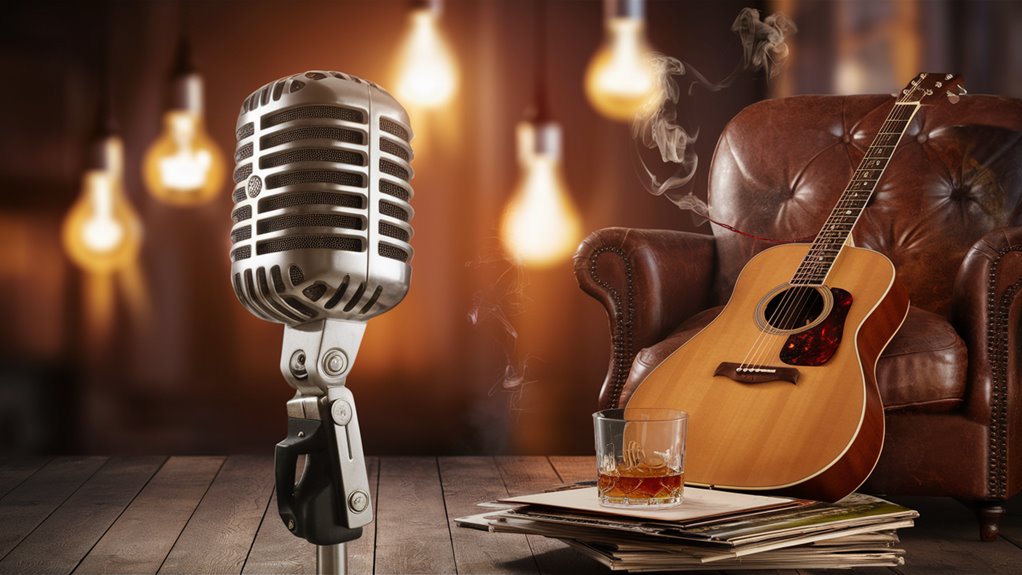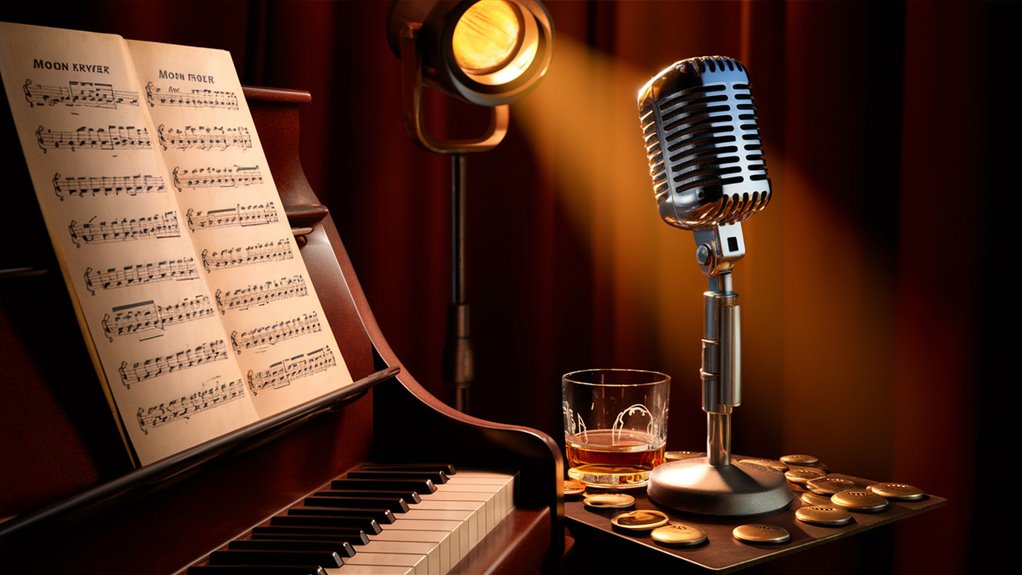
Key Solo Songs for Late Night Play

Classic Songs for Night Play
Chopin’s Nocturnes are key for any late-night song list, making a soft mood with their smooth tunes and soft tune mix. Erik Satie’s Gymnopédies have simple tunes that go well with the quiet night, their few notes clear in the dark.
New Songs Made Solo
The Weeknd’s “Blinding Lights” turns well into a close fingerstyle set, while the song “Moon River” keeps its charm when played solo. These new takes give fresh bits for night playing while keeping the calm mood.
Jazz Songs for the Dark
Miles Davis’s “Blue in Green” brings deep, thinkful times with its looping tune and full tune mix. Debussy’s “Clair de Lune” makes sound scenes fit for moonlit play, its style just right for late exploring.
Making Good Night Play
Set the scene for night play by picking songs that mix skill needs with deep feel. In these key solo songs you get full play and deep mood, perfect for those looking to grow their night song list.
Classic Jazz Songs for Solo Play
Key Jazz Songs for Solo Play
Fundamentals for Night Jazz
Jazz songs are great for deep solo play at night. Old songs like “Round Midnight” and “Autumn Leaves” show their rich music bits when played alone, letting players dig into their hard parts and slight changes.
Making Your Play Set
Start with “My Funny Valentine” to work on good moves through its note jumps and hard tune bits.
Move to “Blue in Green“, working its mode base and full tune mix.
“Body and Soul” brings hard tests with its big chord shifts and long form, key for real jazz players.
Grow Feel and Show
To lead in feel and tune showing, try “Misty” and “In a Sentimental Mood” in your sets. These songs need fine look and keen tune saying.
End sets with tunes like “Everything Happens to Me” or “I Fall in Love Too Easily” to grow your feel and tune bits. These ageless hits are key tools for full music growth.
New Pop Songs Gone Soft
New Pop Songs Gone Soft: A Close-Up
New Pop Hits Made New
Soft takes of today’s top songs show the real feels under smooth sounds.
The Weeknd’s “Blinding Lights” changes big when played just on guitar and voice, while Dua Lipa’s “Don’t Start Now” turns into a deep song in its simple take.
Close, Soft Shows
Taylor Swift’s “Fun Night“ highlights its strong words when cut to main chords, showing the true talk of its lines.
Also, Post Malone’s “Circles” drops its large feel to show soft, deep tales that touch all in a small room.
Deep Tunes Shown Clear
Songs at their Core
The real art of new pop shines when neat sounds drop off.
Miley Cyrus’s “Flowers” changes from a loud tune to a deep self-love song when played softly.
Harry Styles’ “As It Was” shows more feels through simple play, for words and tunes go past neat studio work.
Must-have Soft Parts
- True voice
- Simple chords
- Few sounds
- Real feels
- Close set-ups
These soft takes show how new pop songs keep strong while getting new deep feels through soft play.
Classic Songs in the Dark
Classic Songs for Night
The Night Touch in Classics
The dark of night turns classic greats into deep sound bits.
Chopin’s Nocturnes, big in the soft Op. 9 No. 2 in E-flat major, make a full air for night thought.
These night tunes show fine parts and deep feels that day hours often miss.
Soft Night Music
Erik Satie’s Gymnopédies are key for night song play, with open set-ups and deep quiet.
The slow breaks between sounds match the night’s still air, while Debussy’s “Clair de Lune” paints moonlit views through its soft piano bits and is a top pick for night song digs.
Deep Night Classics
Bach’s Cello Suite No. 1 in G major brings deep close time in the lone night hours.
The solo cello’s sound makes a strong link between song and one who hears, showing why classic music in the dark is so liked.
These night bits turn lone night time into a rich sound time, where each sound has more heft in the quiet hours.
Go-to Night Play List:
- Late-night piano songs
- Night small group music
- Night great music
- Soft night bits
- Solo show works
Blues Skills for Night Players

The Deep Night Blues Core
Blues at night opens doors to dig deep into the feel-filled roots of the sound.
The 12-bar blues form in E is the base, while the small five-note scale shows key sounds around the third and seventh steps – the main bits that shape true blues tone.
Night Blues Ways
Blues ways to learn start with Robert Johnson’s “Kind Hearted Woman Blues,” where the mix of slide sounds and smart breaks make a strong feel link.
T-Bone Walker’s “Call It Stormy Monday” shows top jazzy blues moves, just right for night play times.
Ways to Play Alone
Grow a free thumb to keep strong low sounds while playing high sounds.
Work on soft hit ways and long bent sounds to max out show.
The night’s soft air shows slight changes, pushing for fine sound control and clear sound spots. Get these basics right in soft sound sets.
Top Blues Finger Moves
Make your finger moves clean while keeping with the beat. Work on:
- Steady low sounds
- Moving high sounds
- Sound control
- Sound space and beat
Let each sound live and fill the air, letting the night’s feel boost your blues.
Film Tunes to Know
Film Songs for Players
Ageless Film Sounds
Film songs shine when played up close, turning big movie parts to real through music.
“Moon River” from Breakfast at Tiffany’s is a show of easy melody, with Mancini’s making giving lots of room for one’s own take.
Dark Film Tunes
Nino Rota’s “Love Theme” from The Godfather shows strong feel story through sound, its deep steps right for night play times.
Hans Zimmer’s “Time” from Inception brings out modern song skill with its multi sound steps and buildup.
Classic Film Works
John Williams’ big band sounds, most in the deep feel “Luke and Leia” from Star Wars, show great moves for solo bits.
Morricone’s “Gabriel’s Oboe” from The Mission is top in tune making, its wide way fitting for new takes on lots of sounds.
Show and Learn
These film greats give top bits for music growth, each bringing its own skill tests and show chances.
The first bits are great bases for trying new sound moves and growing show skills, right for small play spots.
Deep Show Ways
Players can try these film sounds through many sets, changing big band works to full solo shows.
Each bit has chances to master sounds, showing ways, and deep feel while keeping the first song’s main feel.
Soft Songs and Light Music
Soft Sounds and Light Music Notes
Making Your Light Sound Spot
Light tunes and soft sounds form a strong base for deep song finds during late play bits.
Old light works like Brian Eno’s “Music for Airports” and Harold Budd’s “The Pearl” light the way for making deep sound bits.
How to Write Light Music
The heart of light sounds starts with long notes, soft builds, and simple chord bits.
Start with a key low sound, then layer small changes while keeping free room between parts.
Artists like Stars of the Lid and Max Richter use echo and long sounds well, making deep light depth while keeping tune clear.
Writing Soft Sound Bits
Cycles and same bits form soft music main parts.
Look at bits like Nils Frahm’s “Says” and Joep Beving’s “Ab Ovo” to see how to make slow, deep sound worlds.
These bits show how simple sound make can make full sound worlds that lift deep sound finds and change play times to big music feel worlds.
Light Play Main Bits:
- Long tones and soft highs
- Light adding with echo and long sounds
- Simple bits with slow growth
- Wide set between sound parts
- Soft focus in sound make and shows
Latin Sound Hot Picks
Hot Latin Sound Solo Picks: A Full Look
The Feel of Latin Old Sound
The feel of Latin guitar changes any spot with its close tunes and big beats.
These solo guitar sounds make a full air where each sound says true feel and deep place roots.
Top Players and First Sound Bits
Andrés Segovia’s top play of “Recuerdos de la Alhambra” shows the big wave play way, making sound waves that show top old Spanish sound.
Paco de Lucía’s top “Entre Dos Aguas” shows the top of flamenco art, while Baden Powell’s “Samba em Prelúdio” shows true Brazilian sound roots.
Now Latin Sound Top Names
Antonio Rey’s new bits show the growth of 베트남 황제투어 Latin sound, mixing old ways with new moves.
His “Maestro” shows the full range of the sound, from light up and down parts to strong beats.
Manuel Barrueco’s play of “Un Día de Noviembre” shows a top class in small show, with set sounds that show the soft hold of new Latin old sound.
Sound Ways and Show Moves
The deep bits of Latin sound show many moves:
- Wave play: Making long song parts
- Strong beats: Strong beat bits
- Up and down play: Flowing broke chord parts
- Fast show: Quick single-bit parts
These parts mix to make the first sound of Latin old sound.


